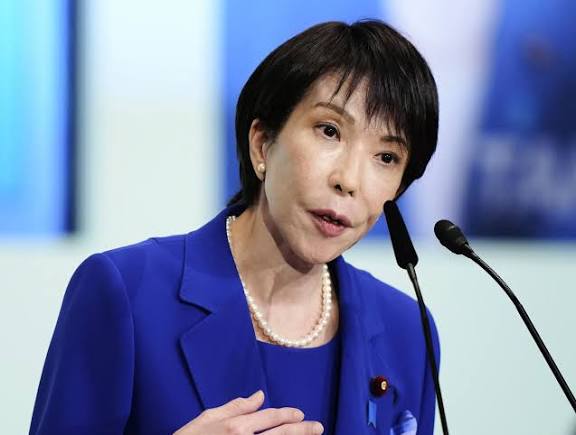Japanese prime minister election results 2025: system,new Prime Minister name,Sanae Takaichi

Lawmakers in Japan elected hard-line conservative Sanae Takachi as prime minister on Tuesday. Today we will discuss about Japanese prime minister election results 2025: system,new Prime Minister name,Sanae Takaichi
Japanese prime minister election results 2025: system,new Prime Minister name,Sanae Takaichi
On October 21, 2025, Japan’s parliament elected Sanae Takaichi as the country’s first female Prime Minister, marking a historic milestone in Japanese political history. Her rise represents both a symbolic and strategic shift in the nation’s leadership as she takes office amid political turbulence, economic challenges, and a changing global landscape.
This article explores the 2025 Japanese Prime Minister election system, the results, Sanae Takaichi’s political journey, policy priorities, and the implications of her leadership for Japan and the world.
1. Background: Political Landscape Leading to 2025

The LDP’s Long Reign and Recent Setbacks
Japan’s Liberal Democratic Party (LDP) has dominated the nation’s politics almost continuously since 1955. Yet, by 2025, its hold on power was weakening. The upper-house election in July 2025 saw the LDP-Komeito coalition lose its majority, a clear sign of public frustration over slow economic growth, inflation, and political stagnation.
Leadership Transition within the LDP
The internal leadership race that followed became decisive. On October 4, 2025, Sanae Takaichi won the LDP presidential election, defeating Shinjirō Koizumi in a runoff vote. This victory automatically positioned her as the frontrunner for the prime ministership, since Japan’s prime minister is elected by parliament from among party leaders.
The Resignation of Shigeru Ishiba
The preceding prime minister, Shigeru Ishiba, resigned after the LDP’s poor electoral showing and loss of majority. His departure created a political vacuum. Takaichi’s election as LDP president was therefore not only symbolic but also essential to stabilizing the ruling party.
2. The Japanese Prime Ministerial Election System
Parliamentary Election, Not Direct Vote
Unlike some democracies, Japan’s prime minister is not chosen by a public vote. Instead, the selection occurs within the National Diet, Japan’s bicameral legislature. The House of Representatives and House of Councillors each vote to elect a prime minister, and if different candidates are chosen, the lower house’s decision prevails.
The Role of Party Leadership
The process typically begins within the ruling party. The party that controls the most seats selects its president, who then becomes the prime minister once parliament confirms the appointment. In October 2025, the LDP remained the largest party, making Takaichi’s leadership win pivotal.
Coalition Politics and Majority Requirement
To win the parliamentary vote, a candidate needs a simple majority in the 465-member Lower House—that is, at least 233 votes. Takaichi achieved 237 votes, surpassing the majority threshold and confirming her victory. However, her government’s stability depends on coalition support, as the LDP is still two seats short of a clear majority.
The New Coalition Setup
After years of partnership, the LDP’s alliance with Komeito fractured in 2025. To form a new governing coalition, the LDP turned to the Japan Innovation Party (Ishin). The coalition marks a shift toward more nationalist, reform-oriented policies, aligning closely with Takaichi’s ideology.
3. The 2025 Prime Minister Election Results
The Parliamentary Vote
On October 21, 2025, the Lower House held its vote. Takaichi secured 237 votes, becoming the 104th Prime Minister of Japan. Her victory was confirmed in the Upper House the same day, formally making her the first woman to ever hold Japan’s highest political office.
Historical Significance
This election shattered one of Japan’s last political glass ceilings. Despite Japan being one of the world’s most advanced economies, it had never before had a female prime minister. Takaichi’s win was hailed as a breakthrough moment for gender representation in Japanese politics.
Political Context
Her victory followed months of declining public confidence in the LDP. The 2025 leadership race and subsequent parliamentary vote were as much about restoring party unity and voter trust as they were about individual leadership.
4. Who Is Sanae Takaichi?
Early Life and Education
Born in Nara Prefecture in 1961, Sanae Takaichi was not part of a major political dynasty—an unusual fact in Japan’s often hereditary political class. She studied at Kobe University, later interning in the United States, where she became interested in conservative political thought.
Political Career
Takaichi was first elected to the House of Representatives in 1996 and went on to serve multiple terms. She held several ministerial posts, including Minister of Internal Affairs and Communications and Minister of Economic Security, earning a reputation as a disciplined, results-driven politician.
Political Views
Takaichi is known for her conservative, nationalist orientation. Her main policy beliefs include:
-
Strengthening national defence and revising Article 9 of the Constitution, which restricts Japan’s military role.
-
Deepening the U.S.–Japan alliance and strengthening regional deterrence against China and North Korea.
-
Upholding traditional family values, opposing separate surnames for married couples, and supporting the male-only imperial succession.
-
Promoting economic growth through strong fiscal policy and government-backed stimulus.
Takaichi has often cited Margaret Thatcher as her political role model, embracing a “strong-leadership” style combined with economic conservatism.
Gender Paradox
While she has broken barriers by becoming Japan’s first female prime minister, she is not widely regarded as a feminist figure. Her conservative stance on gender issues contrasts with the symbolic significance of her election, creating a paradox between her personal achievement and her ideological outlook.
5. Issues That Paved the Way for Her Election
Economic Stagnation and Inflation
Japan’s economy in 2025 faced serious headwinds—rising living costs, a weak yen, and sluggish growth. Public discontent over economic management eroded the LDP’s popularity, creating demand for a leader promising decisive action.
Security Concerns in the Indo-Pacific
Increasing tension with China and North Korea raised calls for stronger defence policies. Takaichi’s hawkish stance on national security resonated with conservatives and defence-minded voters.
Coalition Disruption and Party Turmoil
The collapse of the LDP-Komeito alliance forced a strategic realignment. Takaichi’s willingness to work with the Japan Innovation Party demonstrated her pragmatic approach to preserving LDP dominance amid shifting parliamentary alliances.
Gender and Symbolism
Although her campaign did not centre on gender equality, her candidacy was seen as a chance for Japan to modernize its global image. The symbolism of a female leader in a male-dominated system boosted her appeal both domestically and abroad.
6. Policy Agenda: What to Expect from Takaichi’s Government
Economic Revival and Fiscal Expansion
Takaichi has pledged bold action to counter inflation and stimulate growth. She supports a large-scale economic stimulus package, corporate tax incentives, and digital transformation initiatives. Analysts expect policies reminiscent of “Abenomics”, with government spending aimed at boosting demand and competitiveness.
Defence and Constitutional Reform
Takaichi intends to continue Japan’s gradual move toward stronger defence capabilities. She has publicly supported constitutional revisions to allow a more active military role, aligning with growing concerns about regional security. Defence spending is expected to rise beyond 2% of GDP under her leadership.
Diplomacy and Global Positioning
Her foreign policy emphasizes close ties with the United States, India, and other Indo-Pacific democracies. At the same time, she is likely to take a firmer stance toward China and South Korea, emphasizing sovereignty and national interest.
Social and Gender Policy
Although her leadership itself is historic, her administration is expected to maintain traditional social values. Takaichi has voiced caution about rapid social reforms such as same-sex marriage or liberal family laws, preferring incremental change.
Coalition Management and Legislative Strategy
Managing a minority government will be among her greatest challenges. With only a slim parliamentary margin, she must rely on disciplined party unity and negotiation with smaller factions to pass key legislation.
7. The Significance of Takaichi’s Election
A Cultural Milestone
Japan’s slow progress on gender equality makes this achievement particularly meaningful. Having a woman in the top political position is seen as a major cultural breakthrough and could inspire more women to pursue leadership roles.
Continuity with a Conservative Edge
While Takaichi represents change in terms of gender, her policies mark continuity with Japan’s long-standing conservative establishment. She brings a tougher tone on national defence, fiscal pragmatism, and an emphasis on self-reliance.
International Repercussions
Her rise may shift Japan’s diplomatic posture. Allies such as the United States and India have welcomed her leadership, seeing her as a partner who will strengthen regional security cooperation. However, her assertive approach may strain relations with neighbouring China and South Korea.
Domestic Political Impact
The LDP’s ability to maintain control despite losing its upper-house majority underscores the resilience of Japan’s political system. However, public patience is thin. If Takaichi fails to deliver economic recovery or stability, her administration could face early challenges.
8. Challenges Ahead
A Fragile Coalition
The LDP–Ishin coalition holds only a narrow edge, falling short of a stable majority. Legislative deadlocks, policy disagreements, and potential defections pose serious risks to her agenda.
Economic Pressures
Takaichi inherits one of the world’s most indebted economies. Balancing fiscal expansion with long-term sustainability will be a delicate act. Rising global energy costs and domestic inflation further complicate the outlook.
Regional Tensions
Japan’s relations with China and North Korea remain tense. Takaichi’s hawkish image may heighten friction in the short term, even as it strengthens Japan’s security alliances.
Gender Expectations vs. Policy Reality
Many citizens—especially women—hope her leadership will usher in a new era of equality. Yet her own traditionalist views could limit progress on workplace reforms, childcare support, and equal representation.
Political Longevity
Japanese prime ministers often face short tenures due to intraparty rivalries and volatile approval ratings. To survive politically, Takaichi will need to maintain both parliamentary and public support—no easy task in Japan’s current climate.
9. What to Watch in the Coming Months
-
Cabinet Composition – Observers are eager to see whether Takaichi appoints more women and reform-minded figures or maintains a conservative lineup.
-
Economic Stimulus Package – Details of her first budget will reveal how aggressively she plans to pursue fiscal expansion.
-
Constitutional Reform Debate – Watch for moves to formally begin the process of revising Article 9.
-
Foreign Relations – Her early diplomatic meetings, especially with the United States, India, and ASEAN countries, will signal Japan’s new international priorities.
-
Public Approval Ratings – Polls in the months ahead will measure whether her historic election translates into lasting public confidence.
-
Coalition Stability – Any cracks in the LDP–Ishin partnership could trigger early elections or a leadership challenge.
10. Broader Implications for Japan’s Future
Redefining Leadership in Japan
Sanae Takaichi’s rise demonstrates that Japan’s political system—while traditional—can still produce groundbreaking outcomes. Her success has already redefined what leadership looks like in a country long dominated by men.
Balancing Symbolism and Substance
Her election is deeply symbolic, but symbolism alone will not sustain her tenure. Voters expect real improvements in living standards, economic stability, and Japan’s global influence.
Reinvigorating the LDP
The LDP has relied on its legacy of stability for decades, but it now faces growing demands for reform and modernization. Takaichi’s leadership offers both a fresh face and a return to conservative fundamentals—a combination that could either revive or divide the party.
Japan’s Role in a Changing World
With global power dynamics shifting in the Indo-Pacific, Takaichi’s leadership comes at a pivotal moment. Japan’s policies under her government could shape regional security for years to come, reinforcing its role as a central democratic power in Asia.
11. Conclusion
The Japanese Prime Minister election of 2025 will be remembered as a defining moment in the country’s political evolution. Sanae Takaichi has not only broken a historic gender barrier but also taken charge at a time of deep national and international uncertainty.
Her leadership combines symbolism with pragmatism: a conservative vision for economic revival and national strength, balanced by the pressure of being Japan’s first female leader in a demanding political landscape.
Whether she becomes a transformative figure or merely a transitional one will depend on how effectively she tackles Japan’s economic challenges, manages coalition politics, and navigates a turbulent global environment.
For now, her election represents a new chapter in Japan’s story—one that bridges tradition and change, continuity and innovation, all under the leadership of a woman who has already rewritten Japan’s political history.
How useful was this post?
Click on a star to rate it!
Average rating 0 / 5. Vote count: 0
No votes so far! Be the first to rate this post.
About the Author
usa5911.com
Administrator
Hi, I’m Gurdeep Singh, a professional content writer from India with over 3 years of experience in the field. I specialize in covering U.S. politics, delivering timely and engaging content tailored specifically for an American audience. Along with my dedicated team, we track and report on all the latest political trends, news, and in-depth analysis shaping the United States today. Our goal is to provide clear, factual, and compelling content that keeps readers informed and engaged with the ever-changing political landscape.




